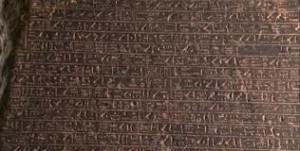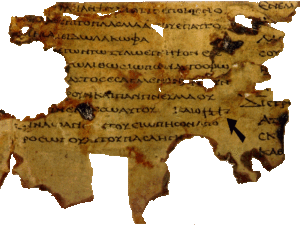Decoding the El Arish Stone – blog entry 3
I’ve been attempting to decipher the El Arish “naos” i.e., shrine. This is the third entry. The “naos” is a granite stone weighing two tons that once stood in the “Holy of Holies” of an Egyptian temple. Some scholars have claimed – and I agree – that what we have here is the story of the Biblical Exodus from an Egyptian point of view. The inscription has never been systematically deciphered – until now.

Part 1 and 2 are here and here.
Before I continue with part 3, I want to address the main objection to this exercise. Until now, scholars and naysayers have dismissed this archeological proof for the Biblical Exodus because the stone dates from the 2nd century BCE/BC. How could this stone be telling the story of the Biblical Exodus, the naysayers argue, when the Biblical Exodus happened somewhere between 1,500 to 1,270 BCE and the stone is dated to 200 BCE? Meaning, there is some 1,300 years between the stone and the Exodus. To my mind, this is a nonsensical objection.
My edition on the Bible was published in 2012, but it would be silly for a future archeologist to surmise that it was written in 2012. Observant Jews believe that the Torah i.e., the five books of Moses, were written at the time of the Exodus some 3,500 years ago. For their part, scholars argue that it was written after the Babylonian exile of the Jewish people i.e., some 2,500 years ago. In any event, though my edition of the Bible may be a couple of years old, the story depicted in it is at least 2,500 years old.
When it comes to the Christian Bible, scholars identify the earliest writings with Paul’s letters (1 Thessalonians and Galatians) estimated to have been written around 50 CE/AD i.e., almost 2,000 years ago. Again, the moral of the story is: something may be published today, but it may have been originally recorded thousands of years earlier. The same goes for the El Arish granite.
Typically, Egyptian chronology is calculated based on Manetho’s Aegyptiaca (History of Egypt). This text was written in the 3rd century BCE (around 250 BCE). Not coincidentally, the Septuagint i.e., the Greek version of the Hebrew Bible also dates to this period, as does the El Arish granite. What does all this mean? Why are all these stories dated to the same period in Egyptian history? Does it mean that all these stories originated in the 3rd century BCE, the “Ptolemaic” period of Egyptian history? No, it simply means that something happened during the Ptolemaic period to get the rulers of Egypt to commission the writing down of their history.

What happened? The answer is simple: this period represented the liberation from foreign, Persian rule. Until 332 BCE, the Persians ruled Egypt. After this, Alexander the Great and the descendants of one of his generals, Ptolemy, ruled the country. During the Persian rule, the conquerors tried to obliterate Egyptian history. As a result, during the Ptolemaic period that followed Persian rule, the new rulers of Egypt commissioned the recording of their ancient history, so that it should never be lost. It was as a result of this policy that Manetho wrote his Egyptian History, the Hebrew Bible was translated and the Egyptian version of the Biblical Exodus was recorded on a granite stone in El Arish.
Put differently, all those who have dismissed the El Arish stone on the grounds that it is written in the 3rd century BCE, you’ve made a terrible mistake. Here you have – in hieroglyphics – a 2,200-year-old version of the Passover story – from the Egyptian point of view – and you’ve ignored it. It’s time for the evidence to be examined.
Back to our analysis.
We left the story off when a Pharaoh known by his divine name, “Shu”, regrouped his army and dedicated a temple to the Egyptian gods, before resuming hostilities with the “Amu”, a Semitic people from the area of Israel. We have identified “Shu” with Pharoah “Kamose”. Line 18 states that Kamose’s special temple had a holy area that no one could enter – except Kamose:
“…and it became a sacred place in At-Nebes. It’s southern side represented the face of Pi-Yarit. Neither gods, nor goddesses, nor men, nor animals were allowed to enter the sacred precinct to learn …18. its mysteries.” [the Pharaoh’s privilege of entering the holy area] was granted at the time of Ra, who built a great wall around the temple, measuring… cubits on its 4 sides. 19… 20 cubits high and 15 cubits thick.
As for the sacred lake of At-Nebes, it was. 20… cubits… Shu (a.k.a. Pharaoh Kamose) commissioned it himself at the time of his majesty, Ra. Neither gods 21… nor goddesses, nor men, nor animals had seen anything like it. They did not comprehend [the meaning of] its dimensions, which were 190 cubits [in length] and 110 cubits in width. The walls were 20 cubits… 22. in height and 15 cubits in thickness. This temple was different from all other temples. Its plans were mysterious. Its meaning, a secret. Then came his majesty, Shu/[Kamose], and was enthroned at At-Nebes. As sure as the sky is fixed, the secret ritual of the temple proceeded… 23. Now his majesty, Shu, was enthroned at At-Nebes. During the season of Akhet [i.e., July – November]… 24. He was declared king of the gods at Yat-Nebes, when he formally ascended the throne of Harmakhis.”
What we see here is nothing less than the prelude to the Exodus. In the north, in the Biblical “Goshen”, we have the so-called “Hyksos” i.e., a Semitic people that the Egyptians called the “Amu”. In the south, we have Egypt’s indigenous rulers mounting a campaign to retake the north. The first leader, Pharaoh Seqenenre Tao II, falls in battle. His son, Kamose, regroups at a place called “At-Nebes” i.e., the place of the sycamores, dedicates a temple reminiscent of the Biblical Tabernacle and is elevated to his father’s throne prior to reengaging with the northerners. It is this very moment that creates the political and historical window for Moses to confront Pharaoh Kamose with the immortal line: “So declares the lord – let My people go!”.
In the next blog, a major figure from the Biblical Exodus is explicitly mentioned in this non-Biblical inscription. To be continued.

